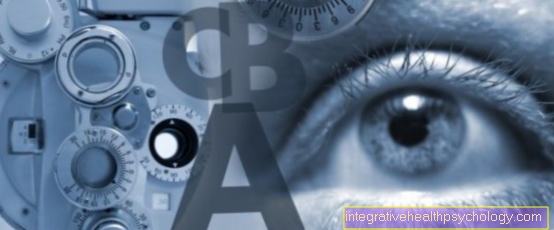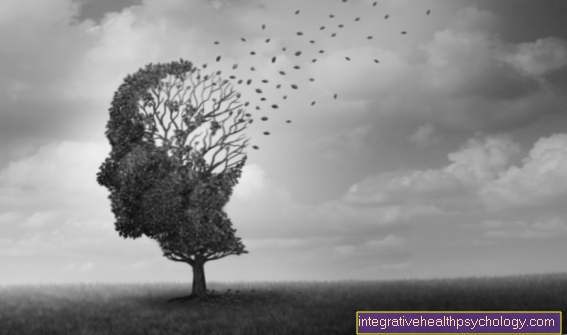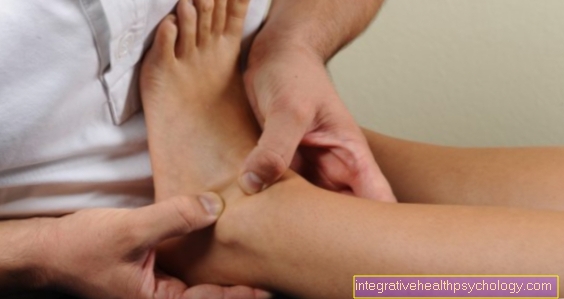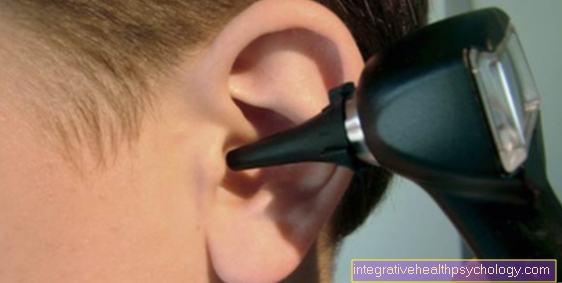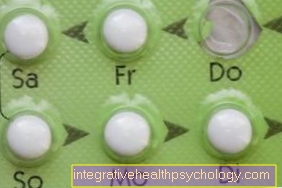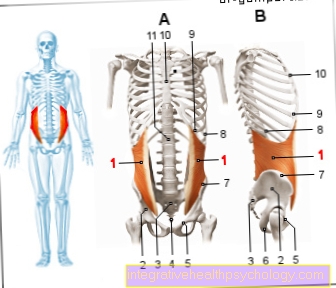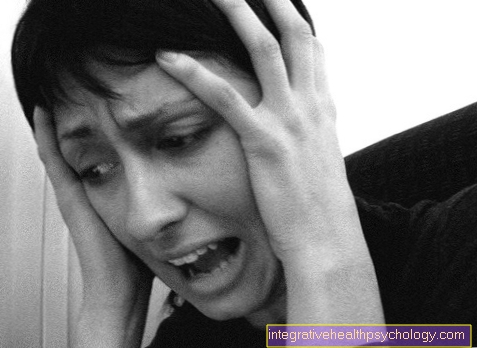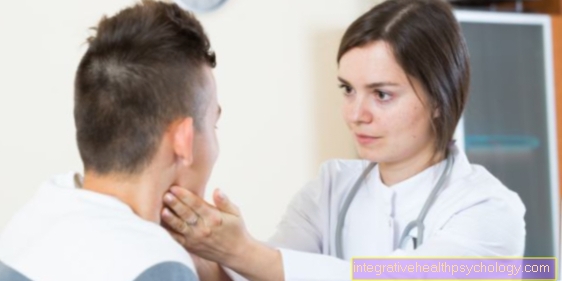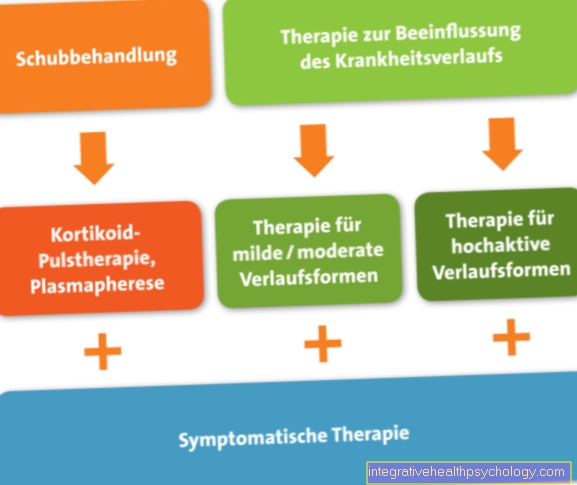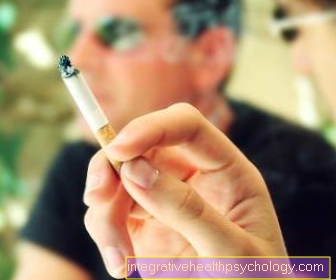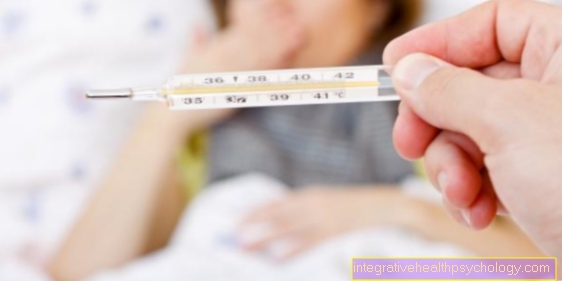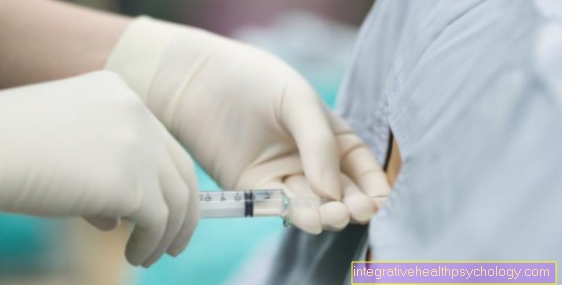Panic attacks
Note
The topic of panic attack is part of our family of topics "Anxiety / anxiety disorder'.
You can find general information on this topic at:
- fear
Synonyms
Anxiety, panic disorder, panic
definition
A panic attack is the sudden occurrence of a physical and psychological alarm reaction with an unclear cause and usually only for a few minutes without an appropriate external cause. The person concerned is often not aware of a panic attack.
The behavior of panic is inherent in every person and serves in earlier stages of evolution to provide energy in life-threatening situations.
Epidemiology
The probability of developing panic disorder in life is between 1.5 and 3% (around half of patients also meet the criteria for agoraphobia).
Women get sick twice more often than men. Panic disorder usually occurs between the ages of 25 and 35. However, the patients who seek treatment are usually a few years older, as they have to go a long way through the physical assessment and diagnosis.
The diagnosis of the panic attack / panic disorder should be made by a psychologist, a psychiatrist or a therapist experienced in the subject. One particular difficulty in diagnosis is that both the patient and the treating physician often suspect physical causes behind the symptoms. In most cases, no abnormalities are found in the physical diagnosis, so that those suffering from panic disorder hear again and again that they are physically healthy. This makes him feel helpless and abandoned.
Symptoms
The main characteristic of panic disorder are what are known as panic attacks. These often “attack” the patient out of the blue and usually cannot be assigned to any particular situation.
A panic attack usually begins with a few symptoms that the patient is often familiar with from previous attacks. (List of symptoms see below) These symptoms are interpreted by the patient as threatening or even life-threatening. The fear increases again through the feeling of threat. A kind of "vicious circle" arises.
Example: panic attack
Mr. A. suddenly notices that his heart is beating faster. He then gets a queasy feeling in his stomach and says to himself: "Now it's going again ..." With a rising heartbeat, he notices a tightness in his chest and thinks: "Oh God, that can't be normal, me get a heart attack. " Then his fear increases and he gets breathless and dizzy ...The rocking between thoughts and physical complaints takes its course.
The most common physical symptoms of a panic attack are:
- Accelerated breathing to the point of breathlessness, often accompanied by tightness in the chest.
- Dizziness, which is often accompanied by a feeling of impotence.
- Nausea, diarrhea, gas, abdominal pain
- Accelerated heartbeat with increased perception of heart stumbling (palpitations)
- Sweating, tremors
- Hot flashes, chills
- Fear of loss of control, fear of death
- high blood pressure
- the feeling that the world around you is becoming "unreal", as in a dream (derealization experience)
However, there are other causes that lead to chest tightness and pressure. To do this, read our article: Pressure in the Chest - These are the causes.
This type of attack usually gets worse within 10 minutes of starting. (some even increase up to 30 minutes). After this, the symptoms flatten again and slowly calm down. However, the problem is made more difficult by the fear of anticipation that follows a panic attack. This is the fear of having another panic attack. One also speaks of fear of fear. The frequency with which such anxiety attacks occur can vary widely. Theoretically, months can pass between 2 attacks, but sometimes it is only a few hours.
If you now imagine that such a threatening panic attack happens to a person in a bus or in a café, you can imagine that a patient will avoid such situations in the future. He “learns” that this situation could be dangerous for him. But also places and situations in or in which he has never suffered a panic attack can be avoided out of fear. It is often enough for the patient to imagine that in the event of a panic attack there, escaping from this situation could be difficult or embarrassing. This problem is called agoraphobia. Translated from the Greek, this means "fear of the marketplace". This was and is still often misunderstood today. It is not just about the fear of large and wide spaces, but is understood as a fear of certain situations, such as those in the Gatherings of people, airplanes and elevators, etc. can also be the content of agoraphobia. Specifically, the patient is afraid that one or more of the above-mentioned physical symptoms could occur in the situations he / she considers threatening and not quickly enough Help may be available or there may be no escape.
For the sick person, not only the panic attack itself is bad, but also the helplessness that he experiences in connection with the occurrence and the influence of these attacks. As already mentioned above, the only strategy he can use is to avoid threatening situations. This means that certain things are only done in the company of others, certain means of transport are no longer used, etc.
Agoraphobia can occur even without a previous panic disorder. Above all, the fear of fear is the driving force that leads to avoidance.
Nocturnal panic attacks can be very stressful for those affected. Find out all the important information about this at: Nocturnal panic attacks - what's behind them?
therapy
The so-called behavior therapy has proven itself as a psychotherapeutic method for the therapy of panic disorder. The central approach of the therapy must be breaking the vicious circle. For example, typical symptoms of panic disorder such as the shortness of breath can be provoked by controlled physical exertion or increased, rapid breathing. Here the patient can learn that he is in control of such symptoms. He not only learns that he can trigger these symptoms himself, but that they do not pose a threat. In addition, through so-called cognitive therapy, the patient learns to deal with anxiety-increasing thoughts and to develop a more realistic view of the physical complaints. (My heart is beating fast because I got excited, it's still healthy)
In the Therapy of agoraphobia The so-called exposure, i.e. the controlled dealing with the fearful situations, can bring significant improvement. In behavioral therapy, a distinction is made in the context of exposure between slow confrontation and approach to the situation, so-called fractional exposure, and the “full broadside”, flooding. The patient is guided directly into the fear-inducing situation, accompanied by the therapist.
Such therapy can be combined with drug therapy. For the basic treatment, from the group of so-called Antidepressants mainly the so-called SSRIs are used. In the past, good experiences have also been made with drugs from the so-called Tryziklika group. (see also Therapy for depression) .
As with any type of Anxiety disorder Benzodiazepines also have their place in controlled treatment, but not in outpatient treatment, as the risk of addiction is very high. (see also therapy of generalized anxiety disorder)

